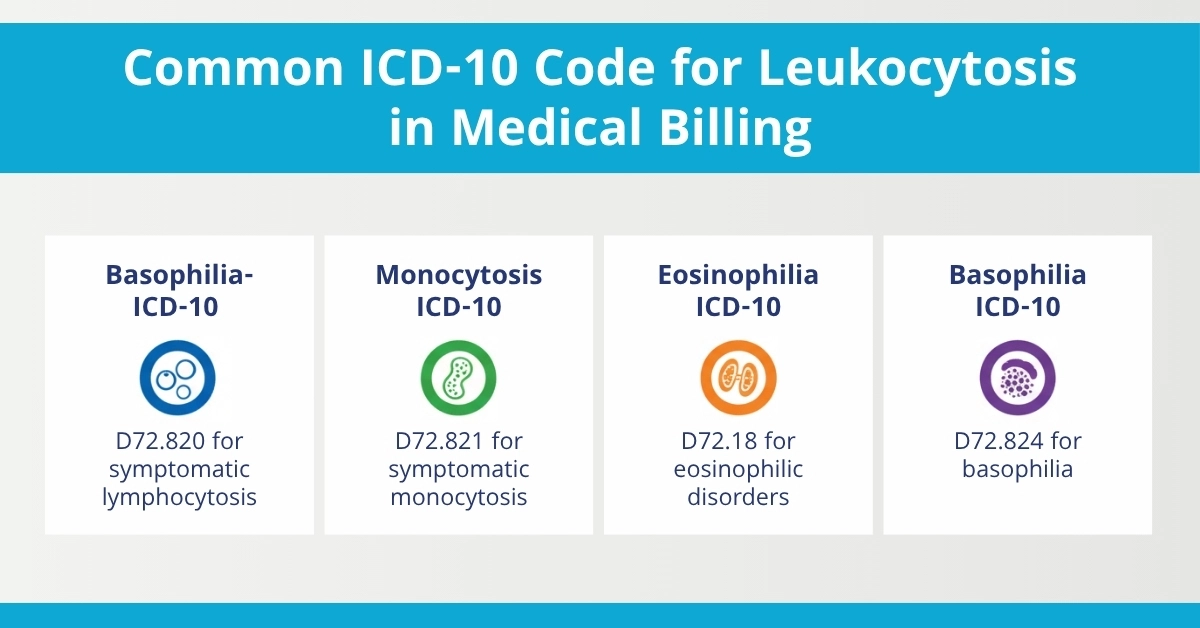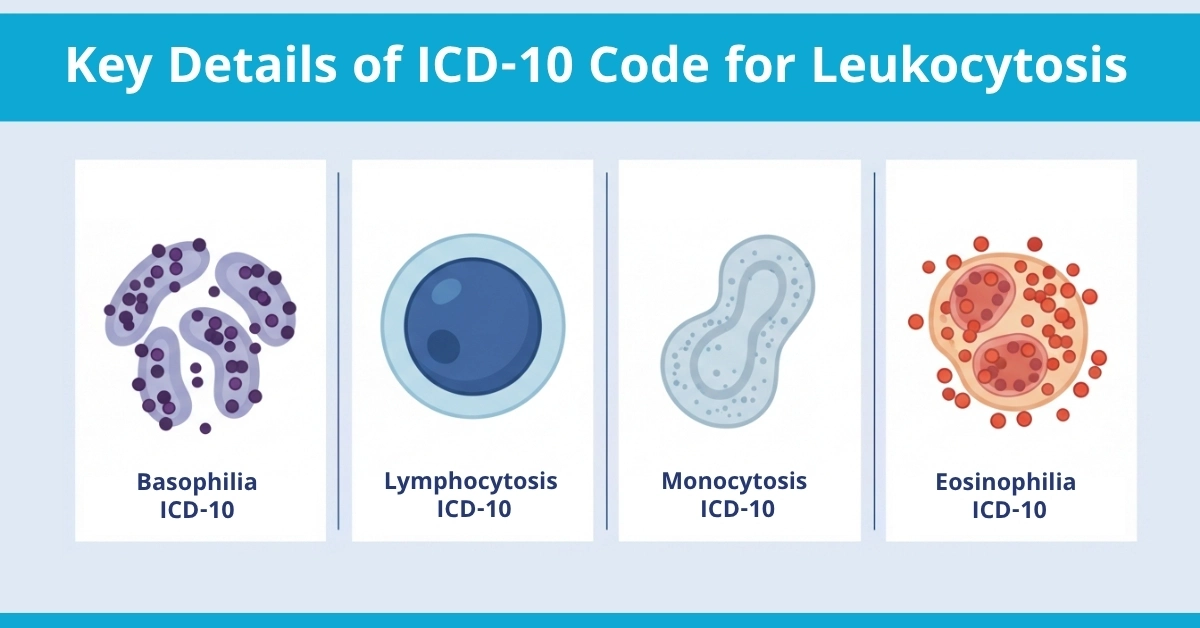Home / Understanding ICD-10 Leukocytosis
In the fast-paced world of healthcare, accurate coding is essential for smooth operations, especially when dealing with blood disorders. For medical billing professionals at Hello MDs, mastering the ICD-10 leukocytosis code can make a significant difference in claim processing and revenue management. Leukocytosis, often indicated by an elevated white blood cell count, is a common finding in lab results that requires precise documentation to avoid denials.
This blog, written by experts of Hello MDs, dives deep into the ICD-10 code for leukocytosis, its implications, and practical tips to optimise your billing workflow. Whether you’re handling routine haematology claims or complex cases, understanding these codes ensures compliance and maximizes reimbursements.
Before exploring the coding aspects, let’s clarify the basics. Leukocytosis is defined as an abnormally elevated white blood cell (WBC) count in the bloodstream, typically exceeding 11,000 cells per microliter in adults. White blood cells are crucial for fighting infections and inflammation, but an elevation can signal various underlying issues.
Leukocytosis is commonly caused by bacterial or viral infections, physical or emotional stress, inflammatory conditions such as rheumatoid arthritis, allergic reactions, smoking, and medications like corticosteroids. In more severe cases, it may result from bone marrow disorders, leukaemia, or complications from trauma and surgery. Identifying the root cause is vital for treatment and accurate coding.
Patients with leukocytosis may not always show obvious signs, but leukocytosis symptoms can include fever, fatigue, night sweats, unexplained weight loss, or bruising, depending on the severity and cause. If left unaddressed, it could point to chronic conditions requiring ongoing monitoring.
Leukocytosis is classified based on the predominant white blood cell type involved:
Each type influences how you approach elevated white blood cell count diagnosis and subsequent billing.

The primary ICD-10 code for leukocytosis is D72.829, which stands for “Elevated white blood cell count, unspecified.” This code falls under ICD-10 CM Chapter D50–D89, which covers diseases of the blood and blood-forming organs, as well as certain disorders involving the immune mechanism. It’s used when the elevation is confirmed but the specific type or cause isn’t detailed in the documentation.
For more precise coding, review related subcodes under D72.82 (Elevated White Blood Cell Count):
Additionally, ICD-10 for high white blood cell count aligns with D72.829 when unspecified, making it a go-to for leukocytosis ICD-10 CM code in general practice. Always cross-reference with lab results for specificity in ICD-10 coding for blood disorders.

Transitioning from older systems? The difference between ICD-9 and ICD-10 leukocytosis is notable in terms of detail and structure. Under ICD-9, leukocytosis was coded as 288.60 for “Leukocytosis, unspecified,” which was broad and lacked the granularity of ICD-10ICD-10 further classifies this under code D72.829 and related codes, providing greater specificity regarding types and underlying causes. This shift improves diagnostic accuracy, supports better data analytics, and reduces ambiguity in claims—key for modern revenue cycle management for ICD-10 codes.
ICD-10’s alphanumeric format (e.g., D72.829) also accommodates more codes overall, enhancing ICD-10 compliance in medical billing by capturing comorbidities and complications that ICD-9 couldn’t.
It’s easy to confuse these terms, but leukopenia vs leukocytosis are opposites. Leukocytosis involves an increase in WBCs (above 11,000/μL), while leukopenia is a decrease (below 3,500-4,000/μL). Leukopenia often results from viral infections, chemotherapy, or autoimmune diseases, leading to a higher infection risk. In contrast, leukocytosis is more reactive to stressors. Accurate differentiation is crucial for documentation for leukocytosis diagnosis to prevent coding errors in hematology claims.
At Hello MDs, we specialize in streamlining medical billing for leukocytosis to ensure your practice thrives. Here are essential ICD-10 medical billing tips:
By focusing on these strategies, you can reduce common denial reasons for ICD-10 coding and enhance overall efficiency.
Navigating ICD-10 leukocytosis doesn’t have to be overwhelming. From understanding its definition and types to mastering billing nuances, accurate use of codes like D72.829 ensures seamless operations and better patient care. At Hello MDs, we’re committed to providing top-tier medical billing solutions tailored to haematology and beyond.
If you’re facing challenges with ICD-10 coding for blood disorders or need help with revenue cycle management for ICD-10 codes, contact our team today for a consultation. Stay compliant, reduce denials, and focus on what matters most—your patients.
D72.829 is used for leukocytosis unspecified. It requires CBC results or lab documentation to ensure accurate billing and claim approval.
It indicates a high white blood cell count without a known cause. Proper documentation is essential for medical coding and insurance reimbursement.
Neutrophilic leukocytosis (neutrophilia) is elevated neutrophils in the blood. The ICD-10 code is D72.820. Correct coding ensures accurate claims.
Common causes include infections, inflammation, medications, stress, smoking, and blood disorders. Specifying the cause supports precise coding.
No. It may result from stress, autoimmune conditions, medications, or bone marrow disorders. Billing should reflect documented causes.
The ICD-10 code is D72.9, used when WBC count is abnormal but the cause is not specified. Documentation ensures proper claim processing.
Leukocytosis = general high WBC count; neutrophilia = specific high neutrophils. Correct selection improves billing accuracy.
Concern arises if leukocytosis is severe, persistent, or linked to marrow abnormalities. Accurate documentation supports medical necessity for billing.
Causes include allergies, autoimmune disorders, chronic inflammation, pregnancy, medications, and cancers. Proper coding ensures correct reimbursement.